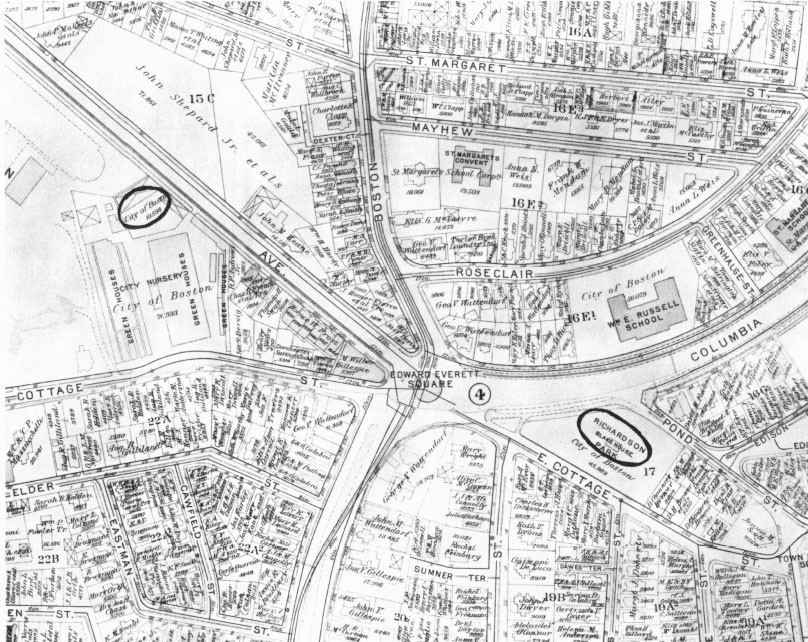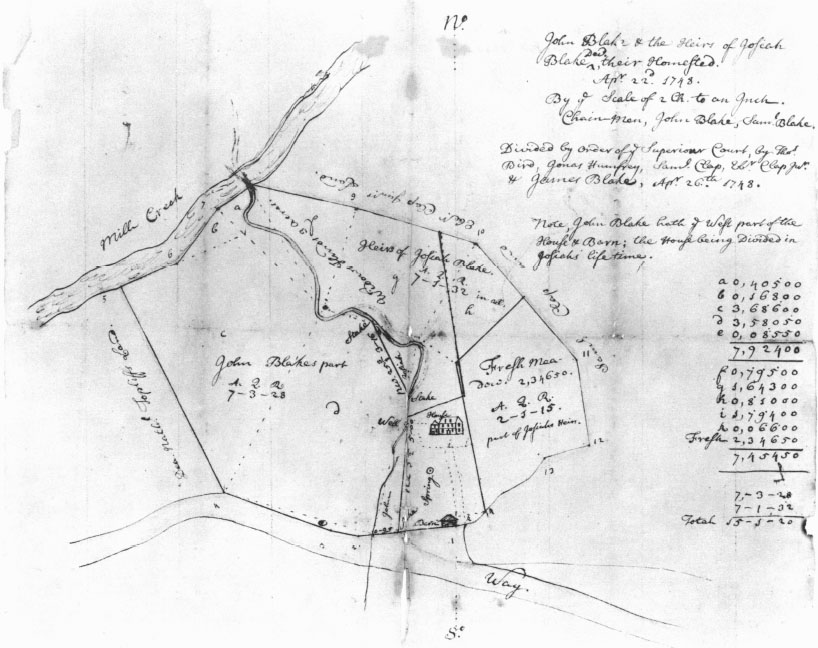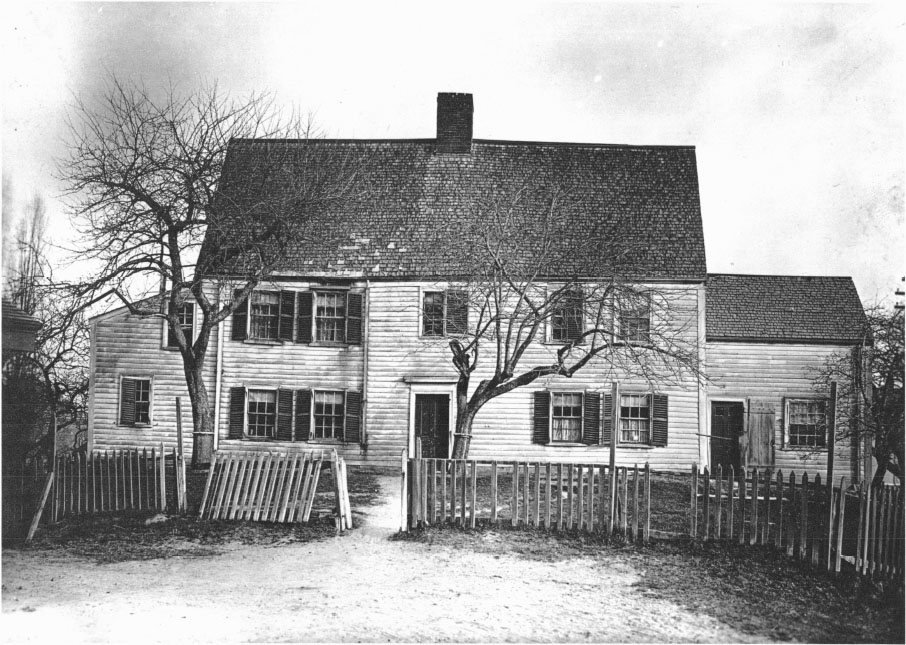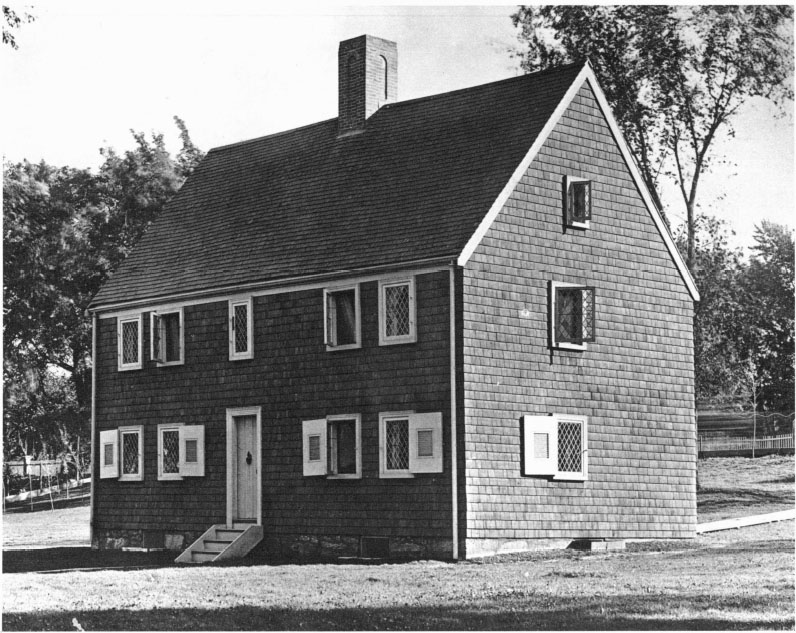Edited by Matthew J. Kiefer
The James Blake House: A Documentary Study
THE relatively small number of extant seventeenth-century houses in Massachusetts and the even smaller number which predate 1660 make a thorough investigation of each critical to an understanding of seventeenth-century Massachusetts architecture. The 1650 construction date traditionally assigned to the James Blake House in Dorchester, placing it within the first generation of New England houses built by carpenters born and probably trained in England, makes the house particularly worthy of scholarly attention.
This brief review of surviving documents relating to the Blake House examines published sources, public records, photographs, and other relevant documents for information concerning the house’s construction date, its ownership history, and the sequence of physical changes leading up to and including its restoration by the Dorchester Historical Society beginning in 1895. Though it fails to confirm or refute a 1650 construction date, this study positively links the house to the Blake family in the seventeenth century, establishes an unbroken chain of ownership from the Blake family to the Society, and reveals the origins of the house’s 1650 attribution.
the published tradition
The generally accepted 1650 construction date is the product of a published tradition over one hundred and twenty years old. Its first-known mention is in 1857, by Samuel Blake (a descendant of the builder of the house), who cites “tradition . . . and . . . the most careful examination of old documents” as evidence that the house was built by James Blake, but gives no source for his contention that “the house was doubtless built previous to 1650.”26 A second source of the same year confuses the house with another, also owned by James Blake; hence the 1680 date of this source may be disregarded.27
Of these two contemporaneous accounts, most subsequent writers have adhered to the former’s 1650 date. Such books as Ebenezer Clap’s 1859 History of the Town of Dorchester, Massachusetts and William Dana Orcutt’s Good Old Dorchester, published in 1893, repeat the 1650 date without either challenge or corroboration. Thus, by the time of acquisition of the house in 1895 by the Dorchester Historical Society, the date had become generally accepted—in spite of the scant evidence supporting it.
An account written for the Society by James H. Stark in 1907 quotes an excerpt from the Dorchester Town Records of 1669, when at a general meeting the town voted to build a new house for the minister “to be such an house as James Blaks house is. . . .”28 It then describes the house in dimensions which closely correspond to the present-day house, thus providing the first documented evidence of the building’s age.
A final explanation for the 1650 attribution date is offered in a 1960 pamphlet published by the Society on the subject of its three houses, which states that “it was probably in anticipation of a marriage that James Blake built his house.”29 Though the date of this event is apparently not recorded, it is known that the first child of James and Elizabeth (Clap) Blake was born in 1652.
ownership history
The James Blake House has been owned and maintained for over eighty years by the Dorchester Historical Society which, following authorization from the Board of Aldermen and mayoral approval, acquired the house in late 1895 from the City of Boston and moved it to its present location in Richardson Park. Interestingly, this is the first recorded instance in New England of a historic building being moved in order to prevent its demolition.
The City had acquired the house on its original site—just west of Massachusetts Avenue about four hundred yards to the northwest of its present location (Fig. 17)—from George J. and Antonia Quinsler in September of 1895, for $8000. The conveyance included nearly 11,000 square feet of land, adjacent to other parcels the City was acquiring for clearance to build municipal greenhouses.30
Antonia Quinsler had gained title to the land in June of 1892 from Josiah F. Williams,31 who had inherited it upon his mother’s death the previous year. Jane Williams’ inventory lists her estate as consisting of a “House, barn, and about 11,000 feet of land,” valued at $2000.32 Jane’s husband, Caleb Williams (1802–1842), a tanner, died intestate; however, an 1843 inventory describes his “House and land situate in Dorchester[,] land ten feet wide around the House and right of passage way to the same,”33 valued at $450.
This extremely small lot was enlarged by his widow the following year through a purchase from the Trustees of the Hawes Fund of a “doughnut-shaped” lot eighty by one hundred feet in extent which surrounded but did not include the houselot itself.34 This parcel of land had descended to the Hawes Fund through Benjamin Hawes, who had acquired it from his uncle, John Hawes, in 1828.35
Jane Williams’ 1843 inheritance of the house and 1844 purchase of the surrounding land ended a period of nearly one hundred and thirty years when the east and west halves of the house and the land surrounding its immediate lot had all been under separate ownership. The process of consolidation had actually begun in 1832, when Caleb Williams purchased from his brother Charles, a laborer, for the sum of $150 “one undivided half part of the land under and ten feet around the dwelling house at present occupied by the said Caleb . . . with all the privileges of passing to and from and around said house and barn, as reserved in a certain deed from Ebenezer Blake to Elisha Clap conveying the other land around said house, and which other land is now owned by the heirs of John Hawes.”36

17. Detail of Edward Everett Square, Dorchester, Mass., showing original and present locations of the Blake house. G. W. Bromley & Co., Atlas of the City of Boston . . . (Philadelphia, 1918), plates 2 and 4.
John Hawes therefore owned not only the land surrounding the house, ultimately sold to Jane Williams in 1844, but also a part of the house itself. His 1819 will, probated upon his death in 1829, mentions each of these pieces of property separately. Clause number 14 of this will devised to his nephew Benjamin Hawes “the use and improvement of the dwelling house in Dorchester, which I lived in last before I removed from Dorchester to South Boston, with the land adjoining said dwelling house, being about nine or ten acres (excepting such part of the premises, as is herein devised to Eunice Williams). . . .”37
The following clause of the will states, “I give and devise to Eunice Williams, wife of Caleb Williams, my part of a dwelling house, situate on the land described in the clause last preceding, now occupied partly by the said Caleb Williams, and partly by Elizabeth Fearn and Rachel Blake, together with the land under said house, and a right of passage to the same sufficient for a Cart way as is now used, with the privilege of the well, and a passage ten feet around the house. . . .”38 Eunice and Caleb Williams were the parents of Caleb Williams, the tanner whose widow, Jane, subsequently bought the first-mentioned parcel from Hawes’ estate.
The portion of the house not bequeathed in the above will, but mentioned as being occupied by Elizabeth Fearn and Rachel Blake in 1819, was purchased by the senior Caleb and his wife, Eunice Williams, in 1825 for the sum of $100 from Rachel Blake.39 The deed reserves to Rachel Blake the right to occupy the house for the term of her natural life—which, as fate would have it, was approximately one month. Thus at the time of the execution of John Hawes’ will in 1829, the entire house was under the ownership of Caleb and Eunice Williams, who had occupied half of it since at least 1819.
It is at this point that the path of ownership becomes somewhat more labyrinthine. The portion of the house owned by Rachel Blake until 1825 will be traced first, in order to help illuminate the more complicated Hawes side.
Rachel Blake was born in 1741, one of five children of John Blake, cordwainer, and Abigail (Preston) Blake. Upon her father’s death in 1772, the absence of a will caused his estate, which included the subject house and barn, as well as some thirteen acres of surrounding land, to be divided equally among his children.40 Each of the individual shares of the surrounding land was sold off separately at different times, and by surviving her four siblings Rachel ultimately gained full possession of the house. Elizabeth Fearn, mentioned in Hawes’ will as a co-occupant of the house, was Rachel’s widowed sister and the last of her siblings to pre-decease her, dying in 1817.
John Hawes, the previously established owner of the remaining half of the house in 1819, purchased it in 1784 from the heirs of his wife’s former husband, Elisha Clap, who had died nine years earlier.41 In 1772, Clap had purchased from Ebenezer Blake, a weaver, for 200 pounds, “my easterly end of a dwelling house and a shop adjoining thereto [,] . . . and my easterly end or half of the barn standing being upon [a piece] of land which peice containeth seven acres one quarter and twenty two rods . . . allowing and reserving out of this piece of land for my uncle Mr. John Blake his heirs and assigns forever Convenient yard room about his part of the house for laying his wood and other necessities and the use of the way from the house to the highway and barn where it is now used. . . .”42
It should be noted that these rights reserved by Ebenezer Blake for his uncle remained attached to later conveyances of the property (in slightly modified form) until at least 1825, after which they were specified to be a distance of ten feet around the house. This remained the bounds of the houselot until Jane Williams enlarged it in 1844.
The above-quoted deed is also significant for its reference to John Blake as the owner of the remaining half of the house, which establishes a familial link between the two separate ownership shares in the house.
Ebenezer Blake had inherited his half of the house and barn from his father, Josiah, a weaver, who died intestate in 1747, and whose inventory lists his interest in the house and surrounding land as being valued at 700 pounds.43 Josiah was the brother of John Blake mentioned in the above deed; hence the house was under the split ownership of two brothers prior to 1747.
John and Josiah were the two youngest of seven children of John Blake (1657–1718), who died intestate with an inventory listing his “Dwelling House” as valued at 50 pounds. The administration of his estate divided the house between his two surviving sons, with sisters Hannah and Elizabeth given occupancy rights until their marriage, when the entire estate would revert to the male heirs.44
John Blake was one of six children of James and Elizabeth Blake. Thought to be the original builder of the house which now stands in Richardson Park, James’ 1700 will devises to his son John “my Dwelling House and Barns, Orchard, Yard, Garden, and ten acres of land adjoining. . . .”45 This is the earliest-known reference in the deed or probate records which can confidently be linked to the same house.
James Blake was born in Pitminster, England, in 1624, the son of William and Agnes Blake, who, according to tradition, brought their family of five to America on the Mary and John, which landed in Dorchester in 1630. William Blake, who is mentioned in the Dorchester Town Records for the first time in 1637, died there in 1663, his wife in 1678. William Blake’s will, written in 1661, simply divided his estate in half, assigning one part to his five children, and the other to his “beloved wife.” The 1663 inventory of his estate includes only the simple listing: “his house and lands,” valued at 154 pounds and 15 shillings.46

18. Division map of John Blake and the heirs of Josiah Blake, April 22, 1748, showing the Blake house and barn. Courtesy Dorchester Historical Society.
No further records have yet been discovered to describe this house more precisely, or document its passage to James Blake, one of four possible heirs. Although the Town Records do make occasional refference to lands granted to or owned by William Blake or, after 1657/8, James Blake, their topographical references are no longer decipherable. It is therefore impossible to say whether the present house was built by James, or inherited from his father’s estate, and the earliest documented mention of the present-day house remains the 1669 reference in the Town Records to building a minister’s house “to be such an house as James Blaks house is.”47
structural history and restoration
A somewhat sketchy structural history of the Blake House has been pieced together from published records, photographs, prints, and other documents. In particular, the records of the Society yield some interesting information about the restoration of the house and the difficulties resulting therefrom.
The precise measurements which follow the aforementioned reference to the house in the Dorchester Town Records confirm that it was originally a simple, four-square structure basically the same in appearance and plan as it is today. The earliest-known graphic representation of the house is a thumbnail sketch in 1748 on a division map of the lands of John Blake and Josiah Blake’s heirs (Fig. 18). This clearly shows not only a two-story ell at the left-hand end of the house, with a pitched roof and separate entrance, but also the suggestion of dormer windows in the front slope of the main house roof. Structural evidence of facade gables, which apparently had survived until 1748, still remain in the attic of the original structure.
Samuel Blake’s account in 1857 contains the next extant representation of the house, a print which shows no facade gables and, in addition to the ell at the left, a story-and-a-half gable-roofed ell at the right end as well which the author claims “has been added within the last quarter of a century.”48 The outline of the house on an 1874 real estate atlas clearly shows it to have an ell projecting from each end. A series of photographs in the collections of the Society for the Preservation of New England Antiquities and the Dorchester Historical Society, several of which were taken shortly before the relocation of the house, confirm that it retained both of the ells until the time of acquisition by the latter Society (Fig. 19).

19. Blake house before removal to new site. Photo, William H. Halliday Collection, before 1896, courtesy Society for the Preservation of New England Antiquities.

20. Blake house after removal to new site and restoration. Photo, William H. Halliday Collection, c. 1896, courtesy Society for the Preservation of New England Antiquities.
The Dorchester Historical Society, which had been incorporated in 1891 and held its first meeting in 1893, undertook the preservation of the Blake House as the first major project of a fledgling organization. Introduced to the plight of the house in June of 1895 by a letter from Doctor Clarence Blake (presumably a descendant of the builder) who offered $500 toward the cost of moving it to a safe location, the Society had within four months secured an agreement with the City of Boston granting the Society the house and the right to move it to nearby Richardson Park at its own expense.49
A major subscription drive (destined to be long-lived) was begun to raise funds for the undertaking. By January of 1896 the house had been moved and re-silled—with both ells having been removed in the process—by a local building mover for $295. The move was accomplished, according to Dr. Blake’s recollection twenty years later, by dismantling the chimney and jacking up the house onto a horse winch.50
Although the name of the moving company and some of the craftsmen involved in the subsequent restoration are identified in the Society’s records, the director of the restoration is unclear. Dr. Blake mentions the assistance of a Mr. Hodgson, “a well known Dorchester architect. . . .” This seems to have been Charles Hodgson, an active member of the Society, who lived near Richardson Park between 1895 and 1907, after which he moved to New Rochelle, New York.
Dr. Blake gives some indication of the actual restoration process in the following passage:
We then tried to have the material in the house duplicated as near as possible to the original material and it was necessary to even send to Holland for the glass in the windows because there was none of its kind in this country. The windows were of the lattice type and on close examination it will even be found that the shingles in the roof are fastened by the original nails which will give you a fine idea of how well built the houses were in those days. The same hinges are even on the doors.51
Because of continuing difficulties in raising funds to pay off debts incurred during the moving and gradual restoration, the Society voted in September of 1898 to float a $1000 bond issue to cover its $800 debt and advance the restoration. However, the Society’s continued difficulty in paying off its debts suggests that the bond issue was a less than raging success. Not until 1907 do the records indicate the Society’s indebtedness to have been discharged.
The actual physical changes to the house resulting from this restoration effort can be partially deduced from contemporary accounts and photographs. In addition to removing both side ells, then-existing double-hung sash windows were replaced with diamond-leaded casements (which may have been shortened slightly); wood shingles replaced clapboards; and a panelled door was removed in favor of a batten door “in the ancient pattern.” The house was placed on a stone foundation, with the front sill raised about one foot above grade in the front.
Structural evidence indicates that then-existing door openings between the house and ell on the present left end of the house, probably enlargements themselves of original windows, were re-converted to windows after the ell was removed. Finally, it should be noted that the pre-restoration chimney, which was apparently later than the house itself, may have remained partially intact during the moving process. Arrived at the new site, this masonry feature underwent repairs, including a new foundation, at which time also recessed arches were added to the front and back of a newly created chimney top.
Although the exterior restoration had been accomplished fairly quickly, restoration of the interior of the house proceeded gradually, beginning with the two ground-floor rooms. It was not until 1910 that the two upstairs chambers were completed and opened to the public. All that can be said of the details of the interior restoration process, based on documentary evidence, is that it included the stripping, staining, and polishing of exposed oak framing; the replacement of most of the structure’s sills and the bottoms of the posts with new oak which was stained and chamfered to match the original timbers; and the “restoration” of the “antique fireplaces.”
Any further determination of exactly how much of the present-day fabric of the house is original and how much the result of this early and well-intentioned restoration effort must be based on careful physical analysis. It is hoped that the claim of a Boston Herald reporter in 1911 that “every piece of old material that could be kept is still in use” will prove true.52

 EDWARD ZIMMER
EDWARD ZIMMER 